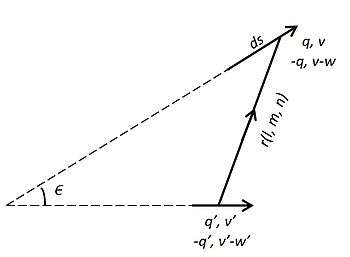Ritz ballistic theory
Ritz ballistic theory is a theory in physics, first published in 1908 by Swiss physicist Walther Ritz. In 1908, Ritz published Recherches critiques sur l'Électrodynamique générale,[1][2] a lengthy criticism of Maxwell-Lorentz electromagnetic theory, in which he contended that the theory's connection with the luminiferous aether (see Lorentz ether theory) made it "essentially inappropriate to express the comprehensive laws for the propagation of electrodynamic actions."
Ritz proposed a new equation, derived from the principles of the ballistic theory of electromagnetic waves, a theory competing with the special theory of relativity. The equation relates the force between two charged particles with a radial separation r relative velocity v and relative acceleration a, where k is an undetermined parameter from the general form of Ampere's force law as proposed by Maxwell. The equation obeys Newton's third law and forms the basis of Ritz's electrodynamics.
Derivation of Ritz's equation
On the assumption of an emission theory, the force acting between two moving charges should depend on the density of the messenger particles emitted by the charges (), the radial distance between the charges (ρ), the velocity of the emission relative to the receiver, ( and for the x and r components, respectively), and the acceleration of the particles relative to each other (). This gives us an equation of the form:[3]
- .
where the coefficients , and are independent of the coordinate system and are functions of and . The stationary coordinates of the observer relate to the moving frame of the charge as follows
Developing the terms in the force equation, we find that the density of particles is given by
The tangent plane of the shell of emitted particles in the stationary coordinate is given by the Jacobian of the transformation from to :
We can also develop expressions for the retarded radius and velocity using Taylor series expansions
With these substitutions, we find that the force equation is now
Next we develop the series representations of the coefficients
With these substitutions, the force equation becomes
Since the equation must reduce to the Coulomb force law when the relative velocities are zero, we immediately know that . Furthermore, to obtain the correct expression for electromagnetic mass, we may deduce that or .
To determine the other coefficients, we consider the force on a linear circuit using Ritz's expression, and compare the terms with the general form of Ampere's law. The second derivative of Ritz's equation is

Consider the diagram on the right, and note that ,
Plugging these expressions into Ritz's equation, we obtain the following
Comparing to the original expression for Ampere's force law
we obtain the coefficients in Ritz's equation
From this we obtain the full expression of Ritz's electrodynamic equation with one unknown
In a footnote at the end of Ritz's section on Gravitation (English translation) the editor says, "Ritz used k = 6.4 to reconcile his formula (to calculate the angle of advancement of perihelion of planets per century) with the observed anomaly for Mercury (41") however recent data give 43.1", which leads to k = 7. Substituting this result into Ritz's formula yields exactly the general relativity formula." Using this same integer value for k in Ritz's electrodynamic equation we get:
References and notes
- Ritz, Walther (1908). "Recherches critiques sur l'Électrodynamique générale". Annales de Chimie et de Physique. 13: 145–275. Bibcode:1908AChPh..13..145R.
- Critical Researches on General Electrodynamics, Introduction and First Part (1980) Robert Fritzius, editor; Second Part (2005) Yefim Bakman, Editor.
- O'Rahilly, Alfred (1938). Electromagnetics; a discussion of fundamentals. Longmans, Green and Co. pp. 503–509. OCLC 3156160. Reprinted as O'Rahilly, Alfred (1965). Electromagnetic Theory. Dover Books. pp. 503–509.
Further reading
- Fritzius, Robert S. (2001). "Abbreviated Biographical Sketch of Walter Ritz (1878–1909)". In Jong-Ping Hsu; Yuan-Zhong Zhang (ed.). Lorentz and Poincaré Invariance: 100 Years of Relativity. World Scientific. pp. 572–573. ISBN 978-981-281-098-4.
- Martínez, Alberto A. (2004). "Ritz, Einstein, and the Emission Hypothesis". Physics in Perspective. 6 (1): 4–28. Bibcode:2004PhP.....6....4M. doi:10.1007/s00016-003-0195-6.